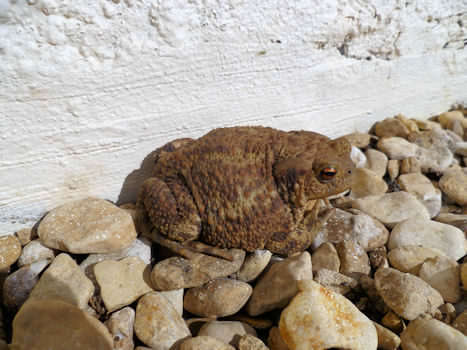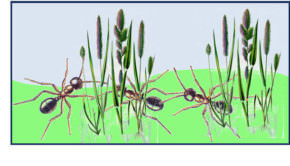Biodiversity Group: The Common Toad
Common toads vary from dark brown, grey and olive green to sandy-coloured. They have broad, squat bodies, a warty skin and tend to walk rather than hop. They are widespread throughout mainland Britain living in and around damp areas in gardens, parks, scrubby areas, woods, fields and ditches. They are creatures of habit and can often be found in the same place again and again, however, because they blend in with the background and can remain motionless for hours they are difficult to spot. They live solitary lives only coming together for breeding in March when they will frequently walk long distances so they can return to the ponds they developed in themselves. The female lays double strings of eggs (up to 5,000 of them) which are fertilised by the male as she lays them. These hatch after about 10 days and the tadpoles then metamorphose into tiny toads (toadlets) over the next 2 months. Toads are nocturnal, foraging for prey at night and spending the day in a small hollow they excavate. They eat flies, insect larvae, ants, spiders, slugs and worms while larger toads may take slow worms, small grass snakes and harvest mice. They do not have teeth so swallow their prey whole. As a defence against predators toads stretch out their legs and inflate their bodies to make themselves look as large as possible. Tadpoles, toadlets and toads also produce a toxic, foul tasting substance through their skin which is enough to put most predators off although grass snakes and hedgehogs are not deterred. Common toads hibernate in October, typically under deep leaf litter or in logs, drainpipes or burrows and occasionally in mud at the bottom of a pond, although they tend to live away from water for most of the year. Although still common their numbers have recently fallen (it is thought up to 20 tons are killed on the roads every year) and they have been included as a Biodiversity Action Plan priority species. They can live for up to 40 years.
Did You Know?
- The colour of the toad varies according to the colour of the soil in its habitat.
- A toad stalks its prey until it is close enough to shoot its sticky tongue out and catch it. To help swallow its food, it blinks to push the food down.
- Male toads croak and produce a high pitched ‘qwark, qwark’ sound when mistaken for a female by another male. Females make no sound at all.
- A toad sheds its skin regularly and then eats it.
- Handling toads with bare hands is not recommended.



